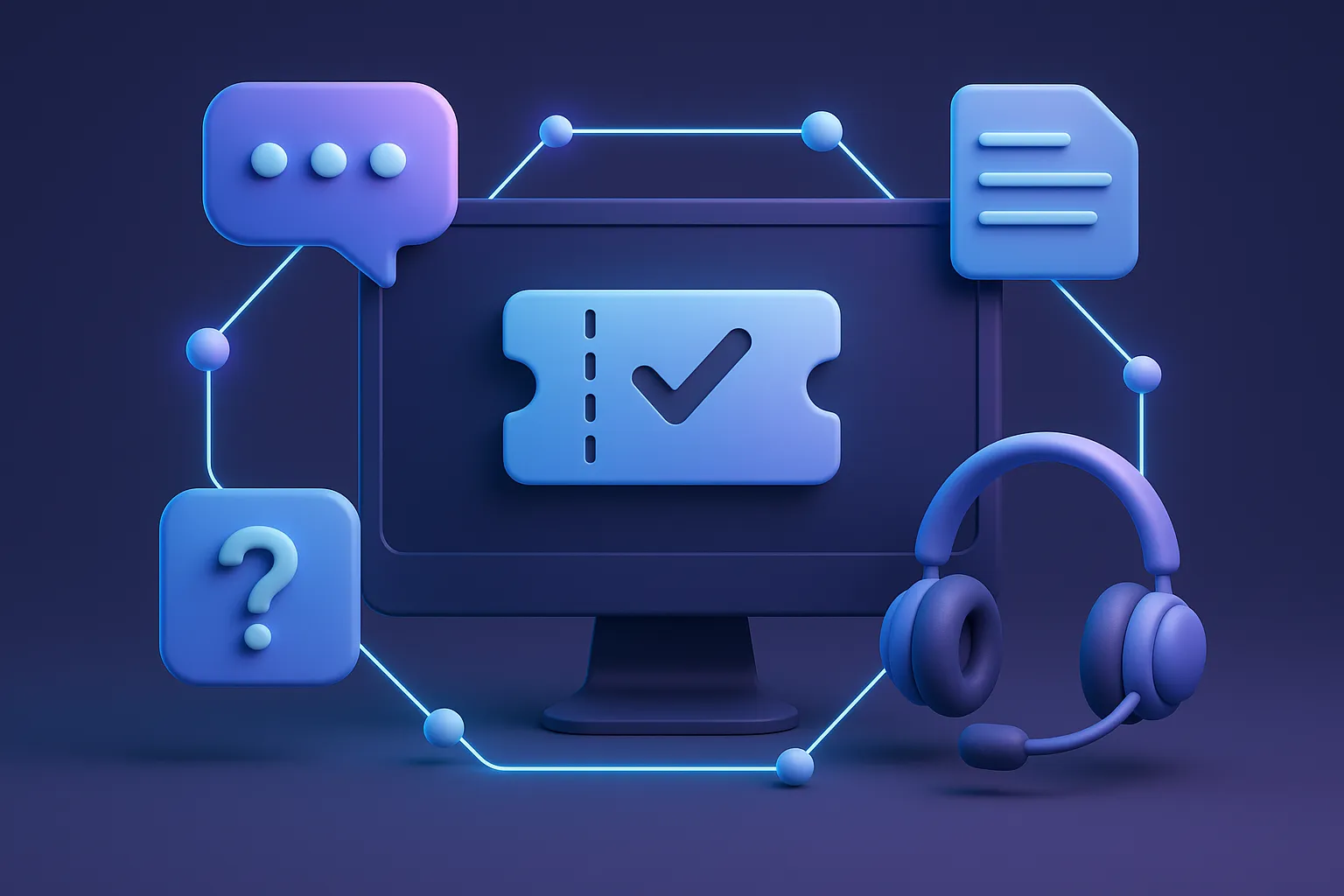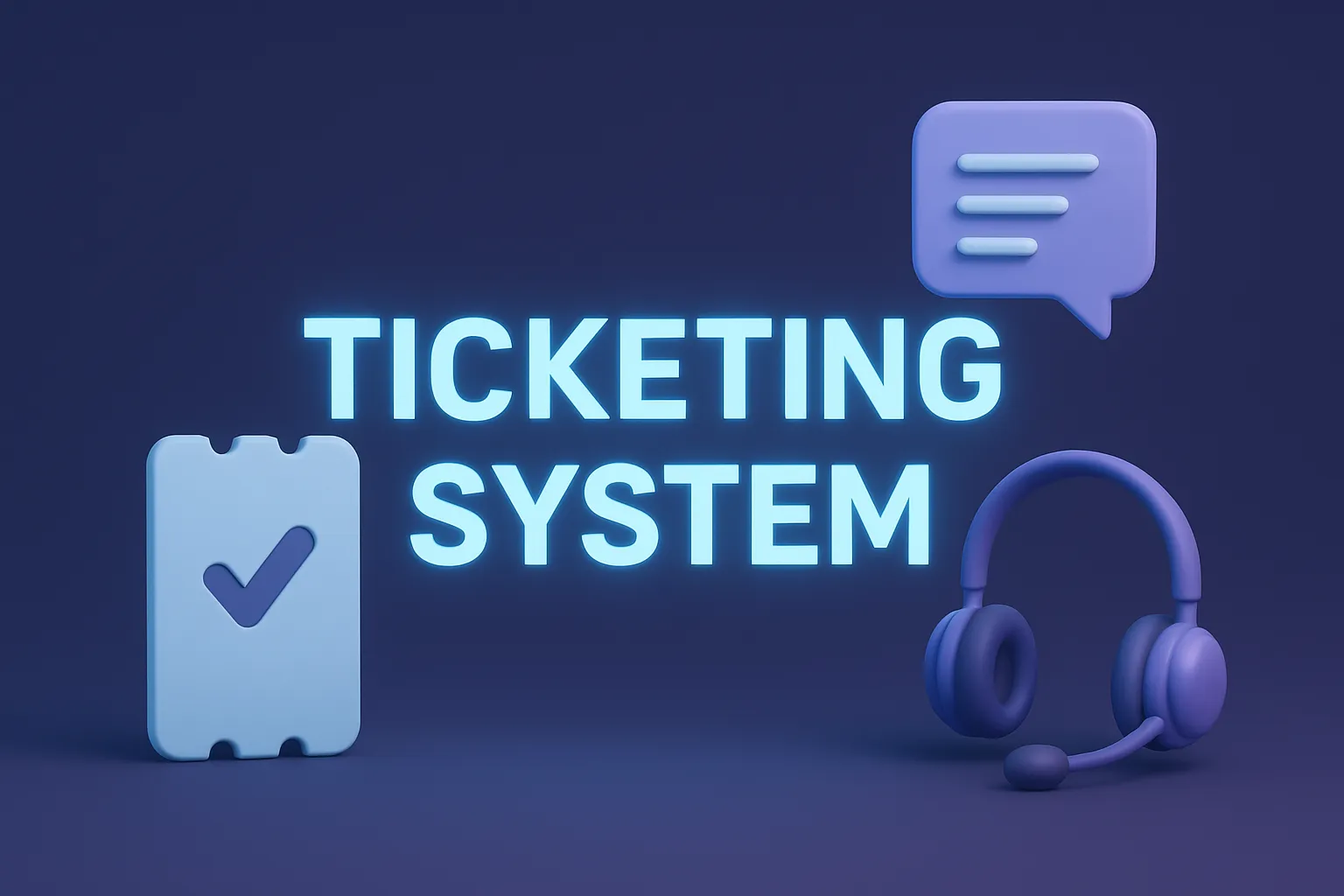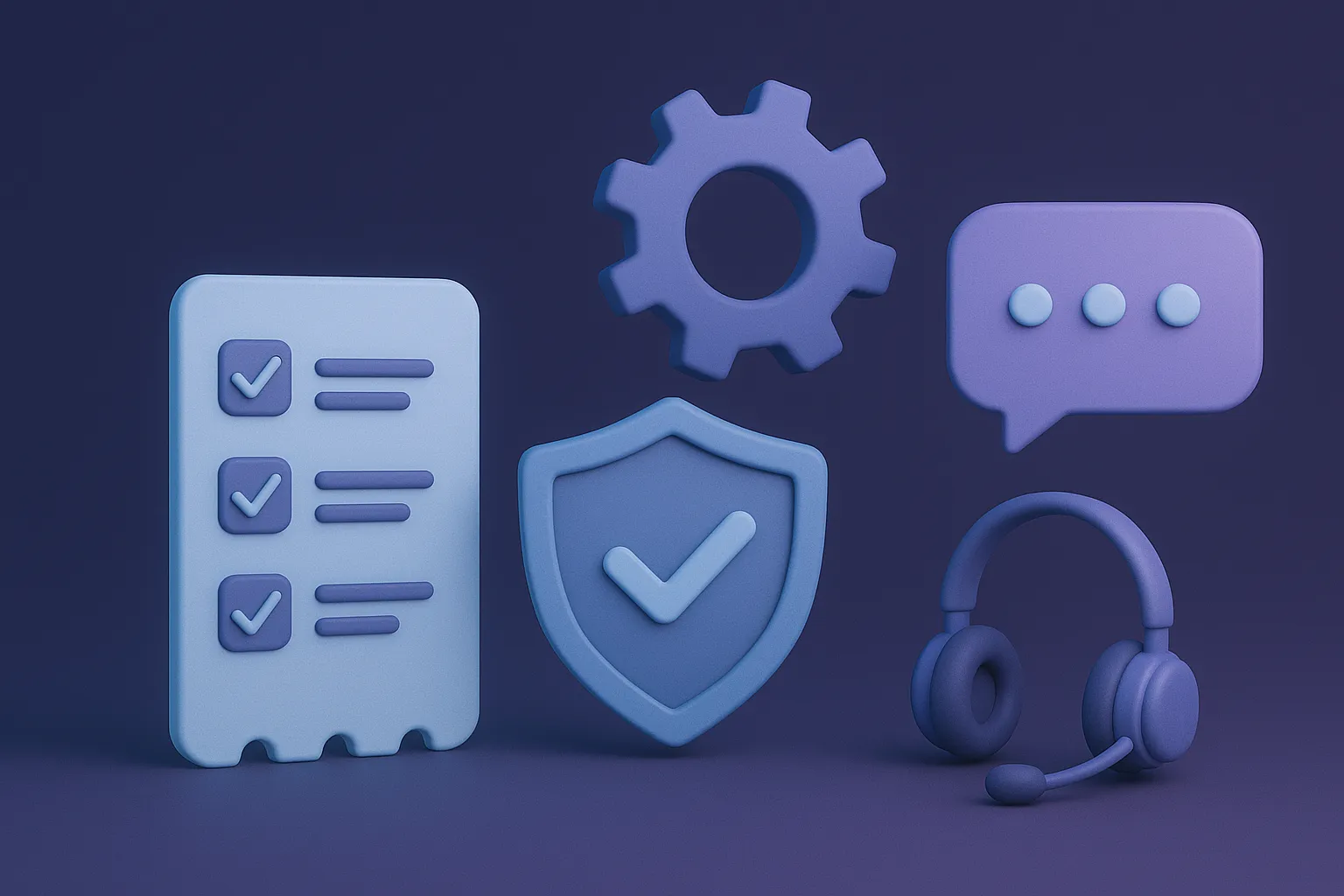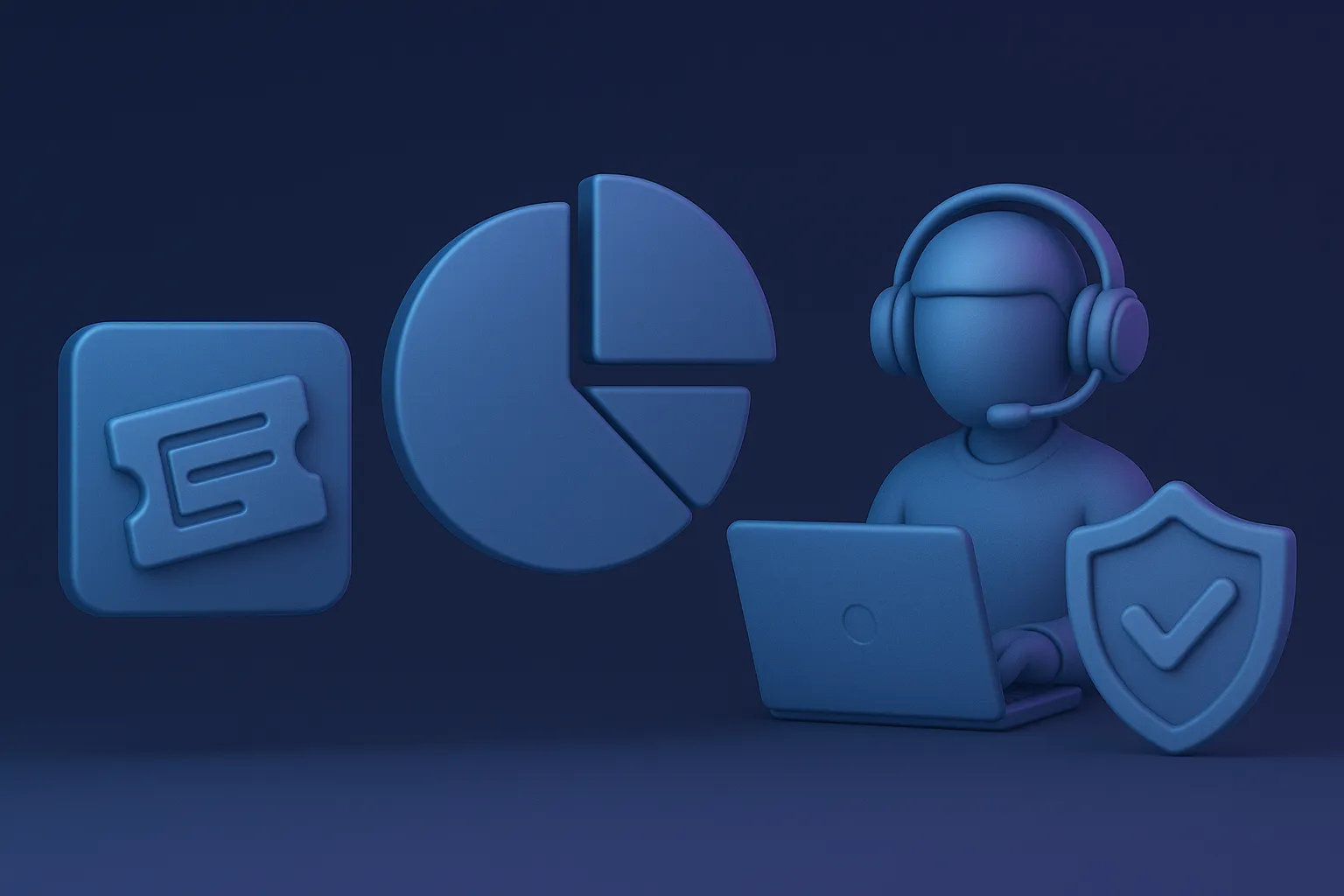October 6, 2025
October 6, 2025

Imagine juggling hundreds of customer emails, chats, and support calls at once. Sounds overwhelming, right? That’s exactly why businesses rely on a ticketing support system. It helps organize every request, track progress, and make sure no issue is left unresolved. Whether you’re running an IT helpdesk or a customer support team, understanding how a ticket system works can be a game changer. In this article, we’ll cover everything you need to know to get started.
A ticketing system (also called a helpdesk system) is a software solution designed to manage, track, and organize customer requests, issues, or inquiries in one central platform. Instead of handling support through scattered emails, phone calls, or chat messages, a ticket system collects all requests, converts them into “tickets,” and assigns them to the right team or agent for resolution.

Each ticketing represents a single case, whether it’s a customer asking for help, reporting a problem, or requesting a service. The system records important details such as the requester’s information, the type of issue, its priority, and the status of resolution. This structure ensures that no request is lost, every issue is tracked from start to finish, and customers get timely responses.
Beyond simple case tracking, a ticket system also provides features like automation, categorization, escalation rules, and reporting. This allows businesses to streamline workflows, improve communication, and create accountability across their support teams. In other words, a ticket system is not just a tool to manage problems, it’s a framework that transforms how organizations deliver customer service and IT support.
A modern ticketing support system is more than just a tool for logging customer issues. It’s a comprehensive platform built to organize communication, streamline workflows, and deliver a smooth support experience. Here are the most important features you’ll often find:

1. Ticket Creation and Tracking
At its core, the system automatically converts customer inquiries, whether they come from email, chat, phone, or a web form into tickets. Each ticket can be tracked throughout its entire lifecycle, from the moment it’s created until it’s resolved. This ensures transparency and makes it easy for both agents and customers to follow progress.
2. Categorization and Prioritization
Not all tickets are equal. A support system allows you to categorize issues (e.g., billing, technical, general inquiries) and assign priority levels based on urgency or impact. This helps teams focus on what matters most and prevents critical issues from being delayed.
3. Automation and Workflow Management
Automation rules reduce repetitive tasks and speed up responses. For example, tickets can be auto-assigned to the right department, escalated if they remain unresolved, or triggered with predefined responses. Workflow management ensures consistency in how requests are handled across the team.
4. Multi-Channel Support
Customers want to reach out in different ways, through email, live chat, social media, or phone. A good ticketing system centralizes these conversations into a single dashboard, so agents don’t have to switch between platforms. This creates a unified and seamless experience for customers.
5. Collaboration Tools
Some issues require input from multiple team members. Ticketing systems often include collaboration features like internal notes, tagging colleagues, or shared visibility, ensuring teams work together effectively without confusing the customer.
6. Reporting and Analytics
Data is key to improvement. Most systems include dashboards and reporting tools that track response time, resolution rate, customer satisfaction, and agent performance. These insights help businesses measure efficiency, identify bottlenecks, and continuously optimize their support strategy.
7. Knowledge Base Integration
Many ticketing systems integrate with self-service resources, such as FAQs or knowledge bases. This allows customers to find answers on their own while also enabling agents to quickly share helpful articles within tickets.
Together, these features transform a ticketing support system into a powerful tool for improving both customer experience and team productivity.
In today’s competitive landscape, customers and employees expect fast, reliable, and transparent support. Without a structured way to manage requests, issues can easily be overlooked, response times get delayed, and frustration builds up on both sides. An IT ticketing support system solves these challenges by giving businesses a centralized, efficient, and trackable process for handling every request.

Here’s why it matters:
1. Centralized Request Management
Instead of juggling emails, chats, and phone calls separately, a ticketing system consolidates all communication into one place. This prevents requests from being lost and ensures that every issue receives attention.
2. Faster Response and Resolution Times
With categorization, prioritization, and automation, support teams can act quickly on urgent matters and resolve tickets more efficiently. Faster responses not only boost productivity but also improve customer satisfaction.
3. Greater Transparency and Accountability
Every ticket comes with a clear trail: who is handling it, what actions have been taken, and what stage it’s at. This transparency builds trust with customers and creates accountability within the team.
4. Improved Customer Experience
A well-managed support system ensures that customers feel heard and valued. They can track their ticket status, receive timely updates, and know their issues are being taken seriously leading to stronger customer relationships.
5. Data-Driven Decision Making
Ticketing systems generate valuable insights through reporting and analytics. Businesses can spot recurring problems, identify bottlenecks in their processes, and make informed decisions to improve both IT infrastructure and customer service.
6. Scalability for Growing Teams
As a business grows, so do its support requests. A ticketing system scales with the organization, handling larger volumes without sacrificing quality or efficiency.
In short, an IT ticketing support system is not just about solving technical issues, it’s about creating structure, efficiency, and trust. For businesses, it can be the difference between chaotic support and a smooth, professional customer experience.
A ticketing system may sound simple in theory, but what makes it powerful is the structured process it enforces. Every request follows a lifecycle, from the moment it enters the system to the point it’s resolved, documented, and analyzed. Let’s take a deeper look at how this works in practice.

The journey begins when a customer, employee, or system raises a request. This could be through an email, live chat, a phone call logged by a support agent, or even an automated alert from monitoring software. Instead of scattering across different channels, the ticketing system consolidates all these inputs into one place.
The system assigns a unique ticket ID and logs essential details such as the requester’s name, contact information, issue description, and timestamp. This ensures that no matter how small or complex the request, it will not disappear into someone’s overflowing inbox.
Example: A customer emails “I can’t reset my password.” The system automatically creates Ticket #5023, labels it “Password issue,” and stores the entire conversation thread for tracking.
Once the ticket is created, the next step is enrichment and triage. This is where the system, often with the help of automation, categorizes the request and assigns a priority level. Tickets might be tagged as “billing,” “technical,” or “general inquiry,” while priorities range from low to critical based on urgency and impact.
Smart systems can pull customer data from your CRM or detect keywords to enrich the ticket with context. For instance, if the user is a VIP client, the system may automatically bump the priority to ensure a faster response.
Why it matters: Without triage, a critical service outage could get buried under a pile of low-priority questions. Proper categorization keeps the team focused on what matters most.
After triage, the system routes the ticket to the right agent or team. Routing can be based on skill sets, workload balance, or department specialization. Some systems use round-robin distribution, while others rely on skill-based routing so that a complex technical issue doesn’t end up in the hands of a junior agent.
Automation rules are especially useful here. For example, all “Payment failed” tickets can automatically go to the Billing Team, while “Server downtime” alerts are routed straight to the IT Operations Team.
Real-life scenario: An e-commerce customer reports “My credit card keeps failing.” Instead of being answered by a general agent, the ticket is automatically routed to the billing specialists who can resolve it faster.
Once assigned, the agent begins investigating and resolving the issue. Ticketing systems provide an agent workspace where the entire conversation history, customer details, and related documentation are visible. This prevents repetitive back-and-forth, since the agent has all the necessary context in one view.
Collaboration is another key feature. If an agent needs help from another department, they can leave private notes, tag colleagues, or split the request into subtickets. This internal communication is invisible to the customer but ensures smooth teamwork behind the scenes.
Why it matters: In traditional email support, handoffs often cause confusion. In a ticket system, every action is logged, and there’s always a clear owner, making collaboration much smoother.
From a customer’s perspective, silence is the worst part of waiting for support. A ticketing system solves this by sending automatic notifications whenever a ticket is created, updated, or resolved. Customers can track the status of their ticket through a portal or email thread.
Meanwhile, agents can provide timely updates to reassure customers that progress is being made. Even a short message like, “We’ve escalated your case to our technical team. You’ll hear back within 24 hours,” can significantly improve the customer experience.
Pro tip: Never underestimate the power of proactive communication. Customers are far more forgiving of delays if they feel informed and valued.
Most businesses work with Service Level Agreements (SLAs), defined response and resolution times for different types of requests. A ticketing system tracks these SLAs automatically, ensuring no ticket lingers unnoticed.
If a ticket nears its SLA limit, the ticketing system can trigger alerts or escalate it to a senior agent. For example, a high-priority server outage might escalate after 30 minutes without resolution, notifying the IT manager directly.
Benefit: This structured escalation prevents critical issues from slipping through and helps companies maintain reliability and trust.
Once the issue has been fixed, the agent marks the ticket as resolved. However, resolution is not just about applying a quick fix, it also involves documenting the steps taken, the root cause, and the long-term solution.
In some workflows, the customer is asked to confirm whether the problem is truly solved before the ticket is closed. This double-check adds an extra layer of assurance.
Knowledge capture: If the solution is reusable, the agent can create a knowledge base article so that future customers can solve the issue themselves without opening a ticket.
When the customer confirms resolution (or after a set period), the ticket is closed. Many businesses use this moment to send a short satisfaction survey (CSAT or NPS) to measure the customer’s experience.
Closed tickets are stored in the system as historical data, creating a valuable archive for reporting and training. At the same time, feedback helps managers identify areas for improvement, whether it’s response time, tone of communication, or technical accuracy.
Why it matters: Closure isn’t just the end of a ticket, it’s a feedback loop that helps the support team continuously improve.
The final stage often goes unnoticed but is just as important: analyzing tickets to find patterns and improve processes. Reports and dashboards highlight metrics like average resolution time, ticket backlog, or the most common issue categories.
For high-impact incidents, teams can run a post-mortem analysis to uncover the root cause and prevent recurrence. For instance, if “login issues” make up 20% of all tickets, it may be a sign that the product needs better error handling or clearer documentation.
Outcome: Instead of firefighting the same problem repeatedly, the organization can proactively reduce ticket volume and enhance the overall experience.
A ticketing system doesn’t just manage problems, it creates structure, accountability, and visibility. By following this step-by-step process, businesses can transform customer support from reactive chaos into a proactive, measurable, and scalable operation.
Conclusion
A ticketing system is far more than a digital log of customer requests, it’s the backbone of modern support. By capturing every interaction, prioritizing what matters, and ensuring no issue slips through the cracks, it helps businesses deliver faster, smarter, and more transparent service. Beyond efficiency, it builds trust: customers know they’re being heard, and teams know exactly what they need to do.
For growing organizations, this structure is not optional, it’s essential. Whether you’re running an IT helpdesk, managing customer service, or streamlining internal workflows, the right ticketing system can transform how your team operates and how your customers experience your brand.
Now is the time to rethink how your business handles support. If you’re ready to move from scattered conversations to structured, scalable service, investing in a ticketing system isn’t just a smart decision, it’s a competitive advantage.